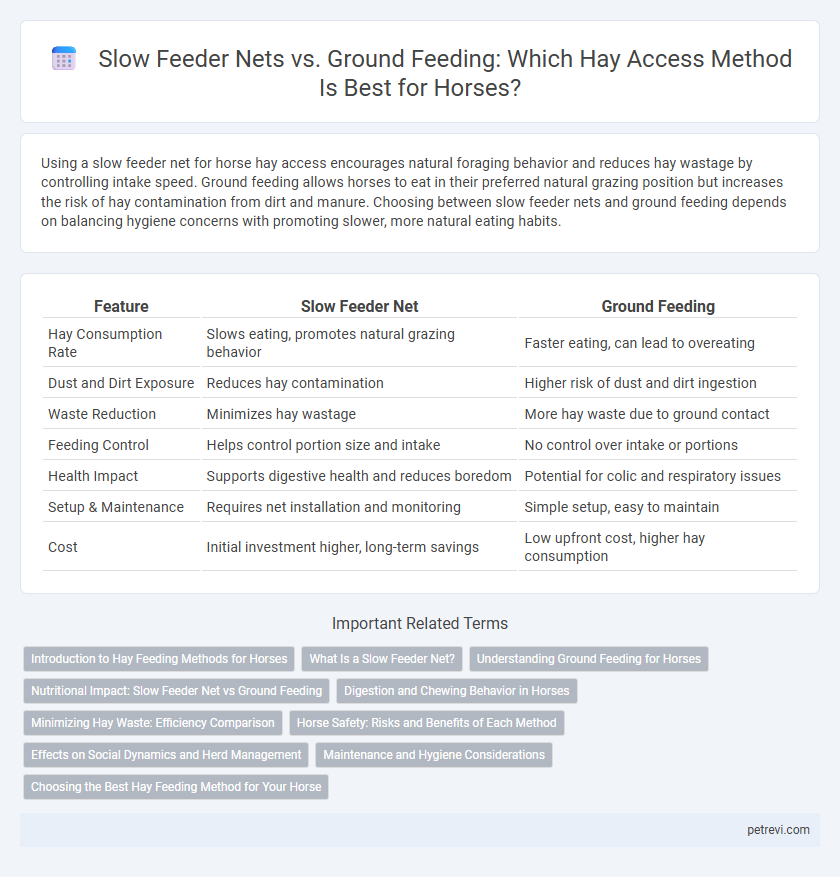Using a slow feeder net for horse hay access encourages natural foraging behavior and reduces hay wastage by controlling intake speed. Ground feeding allows horses to eat in their preferred natural grazing position but increases the risk of hay contamination from dirt and manure. Choosing between slow feeder nets and ground feeding depends on balancing hygiene concerns with promoting slower, more natural eating habits.
Table of Comparison
| Feature | Slow Feeder Net | Ground Feeding |
|---|---|---|
| Hay Consumption Rate | Slows eating, promotes natural grazing behavior | Faster eating, can lead to overeating |
| Dust and Dirt Exposure | Reduces hay contamination | Higher risk of dust and dirt ingestion |
| Waste Reduction | Minimizes hay wastage | More hay waste due to ground contact |
| Feeding Control | Helps control portion size and intake | No control over intake or portions |
| Health Impact | Supports digestive health and reduces boredom | Potential for colic and respiratory issues |
| Setup & Maintenance | Requires net installation and monitoring | Simple setup, easy to maintain |
| Cost | Initial investment higher, long-term savings | Low upfront cost, higher hay consumption |
Introduction to Hay Feeding Methods for Horses
Slow feeder nets regulate hay consumption by limiting bite size and extending feeding time, promoting better digestion in horses. Ground feeding mimics natural grazing behavior, encouraging slower intake and reducing the risk of respiratory issues linked to hay dust. Choosing between these methods depends on balancing controlled intake with natural feeding postures to support equine health.
What Is a Slow Feeder Net?
A slow feeder net is a specially designed mesh bag that regulates a horse's hay consumption by limiting the amount accessible at any one time, promoting slower eating and reducing waste. Unlike ground feeding, which allows horses to consume hay quickly and can lead to overeating or digestive issues, slow feeder nets encourage natural foraging behavior and improve digestive health. These nets vary in mesh size to accommodate different feeding rates, making them an effective tool for managing hay intake and preventing boredom.
Understanding Ground Feeding for Horses
Ground feeding allows horses to consume hay in a natural grazing posture, promoting healthier digestion and reducing the risk of respiratory issues caused by dust inhalation. This method mimics the horse's instinctive foraging behavior, encouraging slower intake and improved saliva production, which aids in buffering stomach acid. Unlike slow feeder nets, ground feeding requires regular cleaning to maintain hygiene and prevent contamination from soil or manure.
Nutritional Impact: Slow Feeder Net vs Ground Feeding
Slow feeder nets regulate hay intake, promoting slower consumption which enhances saliva production and better digestion, reducing the risk of gastric ulcers and colic in horses. Ground feeding allows unrestricted hay access but can lead to rapid intake, increasing the chance of digestive disturbances and nutrient wastage from trampling. Nutritionally, slow feeder nets optimize fiber utilization and minimize wastage, supporting stable blood glucose levels and improved overall gut health.
Digestion and Chewing Behavior in Horses
Slow feeder nets promote slower hay intake, which enhances mastication and stimulates saliva production, aiding digestion and reducing the risk of colic and gastric ulcers. Ground feeding encourages natural foraging behavior and allows horses to select different hay portions, but it may lead to rapid consumption, increasing the chance of digestive upset. Selecting between slow feeder nets and ground feeding should consider individual horse chewing behavior and digestive health to optimize hay access and gut function.
Minimizing Hay Waste: Efficiency Comparison
Slow feeder nets reduce hay waste by controlling the horse's eating pace, preventing rapid consumption and minimizing spillage. Ground feeding allows natural foraging behavior but often results in higher hay wastage due to trampling and contamination. Studies indicate slow feeder nets can decrease hay loss by up to 50%, improving overall feed efficiency and cost-effectiveness.
Horse Safety: Risks and Benefits of Each Method
Slow feeder nets reduce hay wastage and slow intake, promoting better digestion and minimizing colic risk in horses compared to ground feeding. However, improper net design or installation may lead to entanglement injuries or restricted airways. Ground feeding mimics natural grazing behavior but increases exposure to dust, dirt, and parasites, posing health risks such as respiratory issues and gastrointestinal infections.
Effects on Social Dynamics and Herd Management
Slow feeder nets promote longer feeding times, reducing competition and aggression among horses by mimicking natural grazing behavior. Ground feeding allows horses to interact more freely but can increase dominance-related conflicts and resource guarding within the herd. Utilizing slow feeders supports more stable social dynamics and facilitates easier herd management by minimizing stress and injuries.
Maintenance and Hygiene Considerations
Slow feeder nets reduce hay wastage by controlling portion size while minimizing contamination from dirt and manure, enhancing overall hygiene. Ground feeding increases the risk of hay soiling, attracting insects and bacteria, which may lead to respiratory or digestive issues for horses. Regular cleaning and inspection of slow feeder nets prevent mold buildup, whereas ground feeding areas require frequent removal of waste and debris to maintain sanitary conditions.
Choosing the Best Hay Feeding Method for Your Horse
Slow feeder nets regulate hay intake by mimicking natural grazing patterns, reducing waste and promoting better digestion in horses. Ground feeding closely resembles natural foraging, encouraging natural jaw movement and saliva production but may increase hay contamination and wastage. Selecting the best hay feeding method depends on your horse's eating behavior, pasture availability, and risk of respiratory issues from dust or mold.
Slow Feeder Net vs Ground Feeding for Horse Hay Access Infographic

 petrevi.com
petrevi.com